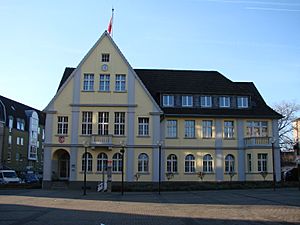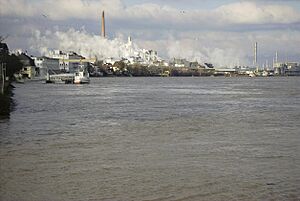Wesseling facts for kids
Quick facts for kids
Wesseling
|
|||
|---|---|---|---|

Old town hall
|
|||
|
|||
| Country | Germany | ||
| State | North Rhine-Westphalia | ||
| Admin. region | Cologne | ||
| District | Rhein-Erft-Kreis | ||
| Elevation | 42 - 62 m (−161.4 ft) | ||
| Population
(2022-12-31)
|
|||
| • Total | 38,192 | ||
| Time zone | CET/CEST (UTC+1/+2) | ||
| Postal codes |
50389
|
||
| Dialling codes | 02236, 02232 | ||
| Vehicle registration | BM | ||
| Website | www.wesseling.de | ||
Wesseling is a city in Germany located right on the Rhine River. It's next to the big city of Cologne to the south. Wesseling is known for its important factories.
The city has three large chemical plants and an oil refinery. This makes Wesseling a key place for making chemicals and fuel for the world.
Contents
Wesseling's Story: From Ancient Times to Today
How Wesseling Got Its Name
People have lived in Wesseling for a very long time! We know this because old Roman altars and a Roman country house have been found there. Even older Frankish burial sites show that people settled here early on.
The name Wesseling comes from the Latin word "Wasliacum." This means "Village of Waslica." There's a fun story that the name came from "changing the rope" for boats. But this story isn't true because the name Wesseling is much older than that boat station.
Early Days and the Start of Industry
Around the 1700s, Wesseling was a place where horses were changed for towing boats along the Rhine. For a long time, Wesseling was a quiet spot between Cologne and Bonn.
Things started to change in 1793 when a tannery (a place that makes leather) opened. This was one of the first signs of industry coming to the area.
Workers and Railways
In 1848, a group called the "democratic workers' association" was started in Wesseling. This was a time when many workers were worried about new technologies.
For example, people who towed boats by hand were worried about steamships. They felt their jobs were in danger.
In 1880, a company called 'Chemische Fabrik Wesseling' was founded. This company processed gas waste and grew into the big Evonik chemical works we see today.
Transportation also improved. In 1904, the Rheinuferbahn (Rhine bank railway) began to connect Cologne, Wesseling, and Bonn. Another railway line, built in 1900, connects Wesseling with Brühl. Today, this line is mostly used for moving goods.
Wesseling During World War II
During World War II (1939-1945), Wesseling's factories were very busy. About 10,000 people from other countries were forced to work there. This was a huge number, especially since the city only had about 7,500 residents at the time.
These forced laborers lived in wooden camps. One camp was near the train station, and another was right by the Rhine River. In March 1945, American soldiers took control of Wesseling as part of Operation Lumberjack.
Wesseling's Economy: A Hub for Industry
Wesseling is a very important industrial city. It has special areas for factories called "Rheinbogen" and "Eichholz."
Many big chemical companies have factories here, like Evonik and Basell. There's also a large Royal Dutch Shell oil refinery. Because of these important factories, Wesseling was a target during the Oil Campaign of World War II.
Wesseling's Neighborhoods
Wesseling is made up of different parts, like neighborhoods. Here's a look at them:
| District | Population | Area [m²] |
|---|---|---|
| Wesseling-Mitte | 12,409 | 7,787,685 |
| Keldenich | 15,000 | 5,535,832 |
| Berzdorf | 4,869 | 4,293,268 |
| Urfeld | 4,057 | 5,756,363 |
| Total | 36,729 | 23,373,148 |
Friends Around the World: Sister Cities
Wesseling has special friendships with other cities around the world. These are called "sister cities" or "twin towns." They share culture and learn from each other. Wesseling is twinned with:
 Leuna, Germany
Leuna, Germany Pontivy, France
Pontivy, France Traunstein, Germany
Traunstein, Germany West Devon, England, United Kingdom
West Devon, England, United Kingdom




